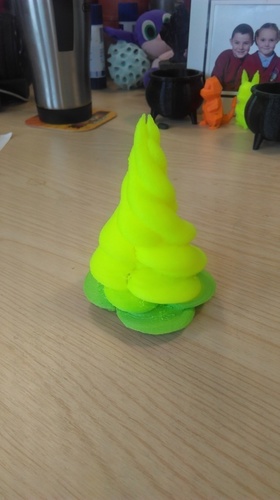
Christmas Tree Isosurface
pinshape
A slight refinement to my code for the Twisted Drop, with a stretch and a Boolean merge with a cone to create a trunk and eliminate some of the weirdness inside the tree. Printer Settings Printer: Eaglemoss Vector3 Rafts: Yes Supports: Yes Resolution: 0.2 mm Infill: 20% How I Designed This I started with code that I give my students to help them start 3D graphics projects. This helps them create models in Vertex and Index Buffers programmatically. I then grabbed the Marching Cubes function from here, and used it so that I could feed an equation into it and get out a Vertex Buffer containing a given isosurface of that equation, display it, and then spit out a basic obj file. My wife commented that the twisted drop looked like a Christmas tree, so I made a slight tweak to the code for it to produce this. The model is in a cubic region 2 Pi on each side and centered at the origin, with a grid of values 100 x 100 x 100 and the isosurface value is zero. This left a few odd bits of other geometry junk in that region, so when I pulled it into Netfabb to stitch it all together, I also removed all of them apart from this piece which I also slightly stretched. The geometry got strung out and tortured on the inside of the "tree", so I Boolean added a plain cone to cover it up and act as a trunk Value Function This is the code that calculates the function/equation value for a given point in space float VBMarchCubes::function(Vector3 _pos) { _pos *= 2.0; float w = _pos.z *1.2f; float x = (_pos.x *cos(w) - _pos.y * sin(w))/(0.25*(_pos.z+XM_PI)), y = (_pos.x*sin(w)+_pos.y*cos(w)) /(0.25* (_pos.z + XM_PI)), z = _pos.z*cos(w)*cos(w); float x1 = _pos.x, y1 = _pos.y, z1 = _pos.z; return ((x + 1)*(x + 1) + (y + 1)*(y + 1) + (z - 2)*(z - 2) - XM_PIDIV2*XM_PIDIV2)*((x - 1)*(x - 1) + (y - 1)*(y - 1) + (z - 2)*(z - 2) - XM_PIDIV2*XM_PIDIV2) *((x - 1)*(x - 1) + (y + 1)*(y + 1) + (z - 1)*(z - 1) - XM_PIDIV2*XM_PIDIV2)*((x + 1)*(x + 1) + (y - 1)*(y - 1) + (z - 1)*(z - 1) - XM_PIDIV2*XM_PIDIV2) *((x + 1)*(x + 1) + (y + 1)*(y + 1) + (z + 1)*(z + 1) - XM_PIDIV2*XM_PIDIV2)*((x - 1)*(x - 1) + (y - 1)*(y - 1) + (z + 1)*(z + 1) - XM_PIDIV2*XM_PIDIV2) *((x1*x1 / (XM_PI*XM_PI) + y1*y1 / (XM_PI*XM_PI) + (z1 - 4)*(z1 - 4) / (XM_PIDIV4*XM_PIDIV4)) - 1); }
With this file you will be able to print Christmas Tree Isosurface with your 3D printer. Click on the button and save the file on your computer to work, edit or customize your design. You can also find more 3D designs for printers on Christmas Tree Isosurface.
